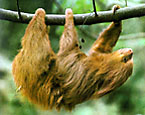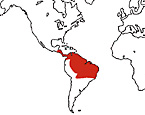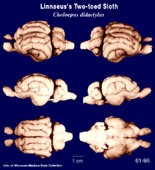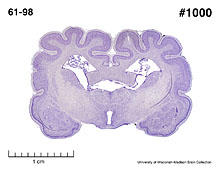|
Linnaeus's
Two-toed Sloth
(Choloepus didactylus) #61-98 |
||||
|
|
Physical
characteristics and distribution
|
|
The
head and body length of Linnaeus's Two-toed Sloth is 540-740
mm, and the tail is absent or vestigal. Weights range from
4.0-8.5 kg. Coloration is grayish brown with a pale face,
and during the wet season, algae growth can produce a greenish
cast in the coat. This growth may provide nutritional benefits
through skin absorption or licking the fur, in addition to
helping camouflage the sloth. Each limb terminates in a long
curved foot. The forefeet have only two digits which are bound
by skin the entire length. The hind feet have three, which
are hooklike claws. They are used to suspend the animal from
tree branches and unlike Three-toed Tree Sloths, these mammals
spend almost their entire lives upside-down. They eat, sleep,
mate and even give birth in this position. When sleeping,
they rest their head between the foreleg, on the chest. The
feet are so close together, the animal looks like a bunch
of dried leaves. They are almost entirely arboreal and nocturnal,
coming down to the the ground about once a week to urinate
and defecate. They are good swimmers, employing a sort of
breast stroke. The distribution of Linnaeus's Two-toed Sloth is in the Guinas and Venezuela (delta and south of Rio Orinoco) south into Brazil (Maranhao west along Rio Amazonas/Solimoes) and west into upper Amazon Basin of Ecuador and Peru. |
|
Description
of the brain
|
|
Animal
source and preparation
|
|
All specimens collected followed the same preparation and histological procedure.
|
Other
Related Resources (websites and publications)
List of Specimens | Explore Collections | Brain Sections | Brain Evolution | Brain Development | Brain Circuitry | Brain Functions | Location and Use | Related Web Sites | Contact Us | Search MSU Database | Personnel | Home



